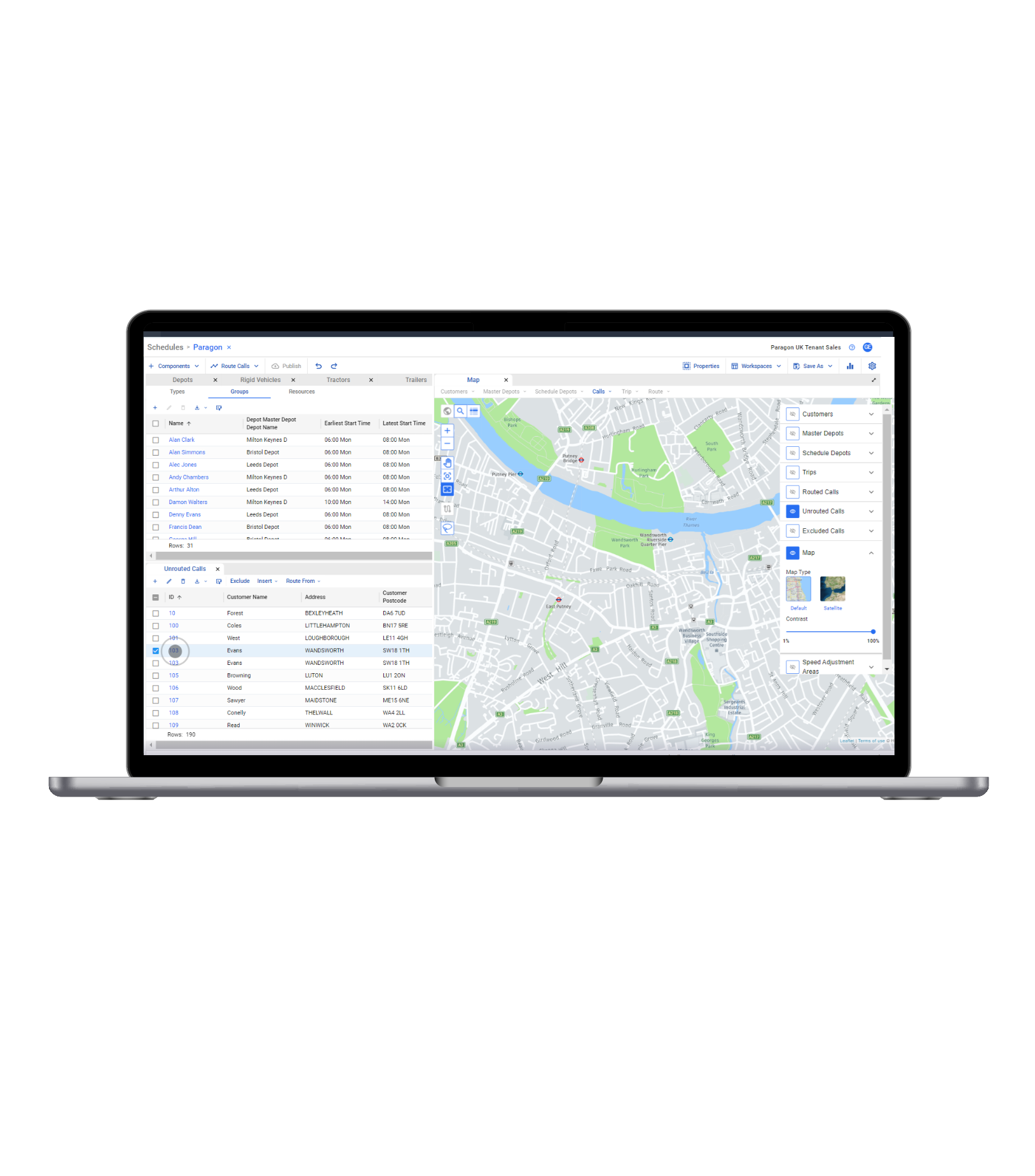The Transportation KPIs You Should Be Tracking
The Transportation KPIs You Should Be Tracking
The Transportation KPIs You Should Be Tracking
16 Juli 2020
 Aptean Staff Writer
Aptean Staff Writer 
What metrics should you be measuring as part of your transportation management KPI dashboard?
Well, here’s the honest (and possibly exasperating) answer: IT DEPENDS.
Sorry, don’t shoot the messenger.
The fact is there are hundreds of transportation KPIs you can measure. You’ll want to zero in on the ones that matter most to your organization – and that you’ll actually act upon. Otherwise, the number gathering becomes just a time-consuming distraction.
We can’t tell you the exact metrics to track for your fleet operation, but we can provide guidance based on Paragon’s work with thousands of fleet operators globally. We’ve seen our share of transportation KPI dashboards, and we understand the power of metrics to drive transformative improvements in cost and service levels.
Why Measure?
How can a good fleet KPI management program help drive meaningful business results? For fleets that plan and schedule routes manually or with basic route planning tools, we typically see an opportunity to reduce total fleet operating costs by 10–30%. Let’s say you were able to optimize routes to eliminate 20% of your fleet’s yearly miles. Using the American Transport Research Institute’s latest cost per truck mile data of $1.82, a 30-truck fleet running 1.5 million miles a year would save $546,000 yearly – dollars that move from an expense line straight to the profit line.
Obviously, KPI dashboards have no direct impact on these cost savings. But they help you identify and attack the various areas of inefficiency that are driving up your costs. Your metrics will likely encompass a range of areas – safety, compliance and customer service, as well as cost – but cost savings provide the most compelling reason to start measuring and improving. We find that larger fleet operations tend to have robust transportation management KPI dashboards. But for many of the smaller fleets – up to 50 trucks – metrics programs are hit and miss. The main reason is lack of time. Lean transportation teams push reporting to the back burner as they scramble to get drivers out the door and manage ETA promises for hundreds of daily deliveries.
Measuring Fleet Performance From the Top Down
When deciding on the right metrics for your transportation dashboard, the best place to start is not the dispatch office, but the board room.
Is the company priority cost control? Improving the customer experience? Reducing the firm’s carbon footprint? The associated metrics for these goals are quite different. Your KPIs may touch on all these areas, but they absolutely must include measures that feed into the top executive’s priorities.
That’s important because performance in certain areas may have to take a hit to maximize performance in others. Here’s an example: a small food distributor that can’t compete with larger competitors on price has established great customer service as its differentiator. Its largest customer on the outskirts of town requires a delivery every Tuesday and Thursday at 7 a.m., even though it would be far more efficient if that location was the 10th stop on the driver’s route. To satisfy this customer, your cost metrics will get worse, while service and satisfaction metrics will improve.
It’s a trade-off, but you need the strategic context to make sense of this choice.
As a logistics and transportation executive, you must drive KPI ownership down to the planning and dispatch level. At the same time, you need to aggregate the data you receive and package it in a way that would be meaningful to board-level executives.
This is probably the biggest shortfall we see in fleet KPIs – the transportation team does not make it easy for senior executives to see the impact of fleet performance on overall company performance. If they did, more businesses would invest in advanced route optimization software that delivers an ROI in three to 12 months.
KPIs to Consider for Your Transportation Dashboard
Your transportation metrics dashboard may include a mix of KPIs that are relevant to different people:
Dispatchers and drivers
Logistics and transportation executives
C-suite executives
At the dispatch/driver level, you’re primarily looking at the comparison between planned vs. actual performance on the route. This requires routing software to integrate with in-cab telematics systems. We’re constantly amazed at the number of fleet operators who invest time to create efficient route plans, but then never bother to check whether drivers are actually following the plan. Using reporting built into route optimization software, you can show drivers the discrepancies between planned and actual performance and ask for explanations. Why didn’t you follow the route sequence in the plan? Why were you delayed 30 minutes at this stop?
At the logistics executive level, metrics become less tactical and more strategic, with KPIs like cost-per-mile, revenue-per-mile, and on-time performance.
At the C-suite level, executives want data aggregated so they can examine strategic trends, not point-in-time measures. Fleet KPIs at this level might include transportation cost as a percentage of revenue, shown over time.
It would be impossible to create a comprehensive list of metrics here, but let’s look at some of the KPIs that could make sense for each of these reporting levels. You’ll want to focus on the ones that are meaningful to your business.
Dispatch and Driver KPIs
Planned vs actual performance
Miles driven
Drop sequence
Number of stops made
Time at each stop
Arrival and Departure times
Safety-related metrics
DOT reportable safety incidents
Speeding incidents
Harsh acceleration or braking incidents
DOT violations
Compliance-related metrics
Available hours of service (HOS)
HOS violations
Unassigned mileage by vehicle
Logistics Executive KPIs
Cost metrics
Cost-per-mile
Revenue-per-mile
Cost-per-stop
Revenue-per-stop
Cost per unit/case/pallet/cube (NOTE: most companies settle on one unit of measure so it can be applied uniformly across transportation and warehouse metrics)
Miles-per-gallon
Engine idle time
Service metrics
On-time delivery percent
Delivered in full (DIF) percent
Delivered in full, on time (DIFOT) percent
Asset utilization metrics
Assets inactive for over two days (NOTE: this suggests whether there is room to downsize the fleet without impacting service)
Parts/Tires/Fuel cost per mile
Preventative maintenance (PM) compliance
PM time as a percent of all maintenance time
Productivity (mainly planned vs actual)
Time-per-drop
You need a balanced set of metrics to accurately assess performance. For instance, if cost-per-mile is your primary cost metric, then a significant reduction in mileage to complete the same deliveries (a good thing) will actually increase cost-per-mile (a bad thing) – assuming you use the same number of trucks. But when you also look at revenue-per-mile, the payoff from the efficiency gains become clear.
C-Suite Executive KPIs
Transportation cost as a percent of company revenue
Recordable safety incidents over time
On-time delivery over time
CO2 emissions over time
Advanced solutions, like Paragon Routing software, allow you to create regular dashboard reports for your executive team that provide an at-a-glance look at fleet performance, including trend lines.
So Many Metrics, So Little Time
There are hundreds of transportation KPIs you could measure. Too few and you can’t tell an accurate story about your fleet’s performance. Too many and you’re drowning in data. At what point do you stop adding rows to the dashboard?
It comes down to the basic fleet management discipline of Plan – Do – Review – Act. Prioritize your transportation metrics based on your company’s strategic goals and then commit to measuring only those you are prepared to act upon.
Absent action, KPIs are just a number in a spreadsheet. Whether you’re measuring 5 or 50 data points doesn’t matter as much as your commitment to monitor your operation and continuously improve.
Your KPI dashboard is your opportunity to align better with your company’s board-level priorities and demonstrate, through data, the transformative power of a well-run fleet operation.
To learn how automated routing solutions can help get you there, speak to the route optimization experts at Aptean Paragon.
Haben Sie die Produkttour ausprobiert und sind Sie bereit, loszulegen?
Buchen Sie noch heute Ihre vollständige Demo mit unserem Team, um zu sehen, wie unsere fortschrittliche Routing-Software Ihnen helfen kann, die Leistung zu steigern.



